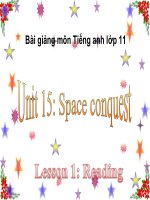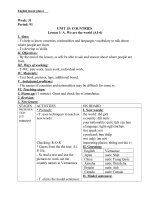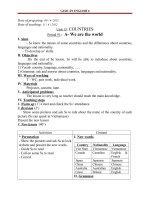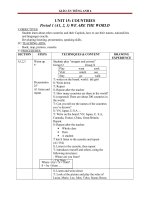Giáo án Tiếng Anh 11 unit 15: Space conquest
Bạn đang xem bản rút gọn của tài liệu. Xem và tải ngay bản đầy đủ của tài liệu tại đây (158.16 KB, 23 trang )
Giáo án Tiếng anh lớp 11.
PERIOD 92
UNIT 15: SPACE
CONQUEST
READING
A. AIMS: - After reading the passage, Ss can learn the meaning of the words,
summarize the main idea of the paragraph and answer the questions
B. TEACHING METHOD: - Communicative approach
C. TEACHING AIDS: - Textbook, pictures, cards and handouts
PROCEDURE:
Teacher's activities
Students' activities
I. Stabilization and check up:
-Ss close the books
- T sticks pictures and cards on the
II. Warm up:
* Match the pictures with the appropriate cards
Pictures
Cards
-Picture 1
Rocket
-Picture 2
The first man to step food on the
moon
board and divides the class into 4
groups
-Group works
- The group which gives many
correct answers quickly will be the
winner
-T leads to the new lesson: ”Space
-Picture 3
Space craft
-Picture 4
The moon’s surface
-Picture 5
The first Vietnamese to fly into
conquest”
- Pair works
space
- T asks Ss
** Questions: What topic we are learning today?
- Ss listen and answer
III. New lesson:
READING
Before reading: Answer the questions
1. Would you like to travel into space?
2. Who is the first human to fly into space?
3. Can you tell me something about him?
4. What made him a hero?
Listen and repeat
** While reading:
Activity 1: Pronunciation
- approximately(adv)
- cosmonaut (n)
- temperature (n)
- psychological (a)
- T asks good Ss to read
- congratulate (v)
- Pair works
Activity 2: Reading text
-T gives handouts to Ss
-New words: Match the words in A with their
- Ss work in pairs to the words in A
definitions in B
with their definitions in B
A
B
- T gives feedback
1. lift off
a. very big
1.e 2.g
2. tragic
b. solve the problem
5.b 6.d 7.c
3. congratulate
differently
c. change or behave
3.f 4.a
due to influence
4. enormous
d. worry about something
5. deal with
e. take off
6. psychological
tension
f. express pleasure at the
happiness
7. react
g. disastrous or greatly
Distressing
- T asks Ss to answer the question:
“ What is the heading of a
paragraph?”
Activity 3:(task 1 page 168 ) Match the
- Ss work in pairs
headings to the paragraphs
- T checks and gives feedback
Para graph 1
A. The tragic accident
P.1-B P.2-D P.3-E P.4- C P.5-A
Paragraph 2
B. The lift-off
Paragraph 3
C. Congratulation
Paragraph 4
D. A view on earth
- Pair works
Paragraph 5
E. Uncertainties
- T asks Ss to read all the questions
and underline the key words
Activity 4: Answer the questions (textbook page
- T calls some pairs to practice
168)
before the class
1. How old was Gagarin when he became the
- Then Ss write their answers on the
first human being in space?
board
2. How long was he in space?
- T checks and gives feedback
3. What questions were raised before Gagarin’s
space flight?
4. What was the speed of his spacecraft in orbit
around the Earth?
5. Why couldn’t Gagarin make a new space
flight?
- Closing books
- T hangs poster on the board and
6. What was done after Gagarin’s death to honor
this national hero?
has Ss guess the missing words
- Ss work in pairs
- T calls Ss and gives good mark to
** Post reading: Complete the summary of the
encourage them.
reading by putting the words / phrases in the box
into the blanks (textbook page 169 )
- Answer key:
1. cosmonaut
4. success
2. in space
5. gravity
7. impossible
3. lasted
6. view
8. named after
IV. Home work:
•
Translate the passage into Vietnamese.
•
Prepare B. Speaking
Ss do the task at home.
PERIOD 93
UNIT 15:
SPACE CONQUEST
SPEAKING
•
OBJECTIVE
Aim(s): speaking about the important events in the space conquest.
Lexical items: words / phrases related to space
Teaching aids: textbook, pictures
•
PROCEDURE
Teacher's activities
Students' activities
Warm-up:
Close the book
T: gives out six pictures of famous astronauts in the
world.
Pairwork
T: asks Ss to look at the pictures and to answer
Ss: answer
1)
Who are they?
Picture 1- He’s Pham Tuan –
2)
What are their nationalities?
Vietnamese astronaut.
Call on some pairs to ask and answer in front of the
Picture 2- He’s Yuri Gararin
class.
– Russian cosmonaut.
Comment and give suggested answers:
Picture 3- He’s Amstrong-
T: introduces the new lesson.
American astronaut.
Activity1
Picture 4- He’s Buzz Aldrin-
Have Ss work in pair and do task 1
T: suggeSs Ss to make questions with
-
When........?
American astronaut.
Picture 5- She’s Valentina
Tareshkova – Russian
cosmonaut.
-
What..........?
Picture 6- He’s Liwei-
-
How old........?
Chinese astronaut.
-
How important.........?
-
How many...............?
Setting model
Open the book
A: When did China launch its first maned spacecraft
Pairwork
into space?
Example:
B: On october 15, 2003
A: What is the name of
T: goes around the class and provides help if necessary
china’s first maned
T: Calls on some pairs to ask and answer aloud in front
of the class.
spacecraft?
B: Its name’s Shenzhou 5
A: What is the name of the
astronaut?
B: His name’s Yang Liwei
A: How old was he when he
flew into space?
B: He was 38 years old
A: How important was the
successful flight to China?
B: The successful flight
marked a milestone in
Activity 2
T has Ss practise making questions and answering about
China’s space protect.
A: How many countries in
the important events in space conquest.(Task 2)
the world have been able to
T: explains and gives an example
carry out independently
(1)
A: When did Russian launch its first artificial
satellite?
B: On October 4, 1957
C: What is the name of Russia’s first artificial satellite?
maned space activities? What
are they?
B: There have been three.
They are: Russia, The United
States and China
D: Sputnik.
A: How important was the artificial satellite to Russia?
B: The first artificial satellite marked the beginning of
Space Age.
(2)
A: Who is the first woman to fly into space?
B: That’s Valentina Tereshkova, a russian cosmanaut.
C: When did she fly into space?
D: On June 16, 1963.
(3)
A: Who are the first humans to set foot on the
moon?
B: They are Neil Amstrong and Buzz Aldrin American
astronauts.
C: When did they set foot on the moon?
D: On July 20, 1969.
(4)
A: Who is the first Vietnamese to fly into space?
B: That’s Pham Tuan
C: With whom did he go along into space?
Groupwork
D: He went with V.V. Gorbotko a Russian cosmonaut.
A: How long did he stay in the orbit?
B: He stayed 8 days in the orbit.
T: asks Ss to work in groups, goes around the class and
provides help when necessary.
Call on some groups to ask and answer aloud in front
of the class
Comment and have necessary corrections
Homework:
Write a short paragraph about the one important event
in space conquest.
Do at home
UNIT 15:
PERIOD 94
SPACE CONQUEST
LISTENING
A. AIMS: - Help Ss to decide true or false sentences and answer the questions
B. TEACHING METHOD: - Communicative approach
C. TEACHING AIDS: - Textbook, pictures, cards and handouts
PROCEDURE:
Teacher's activities
Students' activities
I. Stabilization and check up:
- Work in groups
II. Warm up:
- T devides the class into 4
Matching cards with the pictures
groups
- Ss close the books and
Pictures
Cards
-Picture 1
Orbiting
- Picture 2
The Apollo crew
- Picture 3
Walking on the moon
answers quickly will be the
- Picture 4
The Moon landing
winner
- Picture 5
The first foot print on the Moon
** T leads to new lesson:
representative of each group
write the answer on the board
- Group which gives the correct
Question:” From the pictures can you guess what
topic we are listening today?”
III. New lesson: LISTENING
** Before listening:
-Class work
Activity 1: Pronunciation:
- T has Ss open the book and
-Challenge (v) /………/
look at the words carefully
- Experiment (n)/……./
- T plays the recorder and Ss say
-Achievement (n)/……/
STOP
Activity 2: Listen and repeat: Say STOP if you hear
- T stops the recorder to check
one of these words from the listening passage
** While listening:
Activity 1: Circling the words, phrases or number in
the listening passage you hear Congress, 11,
suitcase, later, press, the first, carry, marry, oxygen,
chicken, 7, step, spacesuit, Apollo, cosmonaut,
temperature, ect……
Activity 2: (Task 1 page 173 ): Decide true /false
- Using handouts
-Ss work in groups
- T gives Ss handouts and has
them work in groups
statements.
- Ss do the task
** Answer key:
- T plays the recorder and then
1.F (In a speech to the Congress )
2.F(There are three astronauts: Neil Amstrong, Buzz
Aldrin, and Michale Collins )
3. F (Neil Amstrong became the first man on the
moon )
4. F (The Oxygen, temperature, and pressure inside
the spacesuit )
feedback
- T asks Ss to read all the
statement carefully and then
guess the statement is true or
false
- T plays the recorder for the
first
- Ss listen and take notes to
5. T
gives the evidence for their
Activity 3: (textbook ) Answer the questions by
answer
circling the letter A, B, C or D
- T calls Ss to answer and plays
1. Which program was developed to meet president
recorder again to check
Kennedy ‘s challenge?
A. NASA’s Apollo program
C. NATO
B. ASIAN
D. VOA
- Using handouts
2. When was the Apollo 11 launched?
- Pair work
A. July 16, 1969
B. July 16, 1996
- T gives Ss handouts, then
C. June 16, 1996
C. June 16, 1969
explains some difficult if
3. What was the portable life support system for?
A. Controlling the Oxygen B. Temperature
C. Temperature and pressure
D. Controlling the oxygen, temperature and pressure
4. How long did the astronauts stay on the surface of
the moon?
A. two and a half hours
C. an hour
B. Half an hour
necessary
- Ss listen and do
- T calls Ss to answer and plays
recorder again to feedback
**Feedback:
1.A
2.A
3.D
4.A
5.D
6.B
D. three and a half hours.
5. What did they do while they were staying on the
surface of the moon?
A. Collect soils and rock samples
B. Collect soil and perform experiments
C. Perform the variety of experiments and collect
soil
D. Perform the variety of experiments, collect soil
and rock samples to return the Earth
6. When did the astronauts return to the Earth?
- Using handouts
A. July 24, 1968
- Ss work in groups of four.
B. July 24, 1969
C. June 24, 1996
D. June 24, 1969
- T explains some difficult
** Post listening: Discuss the reason for the human
words if necessary
interest in Mars and other planets in the solar
- T reads the passage
system.
- Ss listen and do the task
Fill in the blanks with the missing words
- T calls some group and
There are many reasons for human interest in Mars
checks. If any group gives many
and other planets in the solar system. Firstly, Man
correct words, T can gives good
likes (1)………….and wants to find out (2)………
mards
outside the World. One day, we may (3) ………
** Feedback:
people to Mars and other planets in case the Earth is
overpopulated. We may also conduct (4) …………
on Mars and other planets for the (5)………..of
(1) adventur (2) Possibilities of
life
people on Earth. We may find (6)…………minerals
(3) send
(4) researches
there and have trips to other planets for tourist
(5) benefits (6) precious
purposes.
IV. Home work:
Ss do the task at home.
-
Rewrite the above
exercise on your notebooks
Write a paragraph talking 3
things with you if you have a
chance of going to the moon.
PERIOD 95
UNIT 15:
SPACE CONQUEST
WRITING
I. Objectives:
1. Aim: By the end of the lesson, the Ss will be able to write a biography based on
prompts provided.
2. Materials: Textbook, handouts, poster.
3. Lexical items: Words/ phrases used in a biography.
4. Structures: He is a..., He was born in..., In..., he did something, From... to...
Procedure:
Teacher’s Activities
Students’ Activities
Warm up (3’)
Books closed.
- Introduces the lesson by using the picture
Work in pairs.
of the astronaut Neil Amstrong and put
Answer:
questions:
1. He is Neil Amstrong.
2. He is an American astronaut.
3. He set foot on the moon with Buzz
1. Look at the
picture and say who
he is.
Aldrin.
2. Is he a Russian or
an
American
astronaut?
3. Who did he set
foot on the moon
with?
Pre-writing: (5’)
- Asks Ss to read through Task 1 on page
174 and asks Ss what a biography is and
what to be included in a biography.
- Introduces the lesson.
Task 1: (5)
- Explains new words if necessary
appoint vice chairman, committee,
investigate, challenger shuttle disaster
- Asks Ss to do the task
Biography is the written history of a
person's life
Task 2: (12’)
Date of birth
Place of birth
Instruction: You are required to write a
biography of Neil Amstrong from the
information
Biography
Career
given in Task 1.
- Asks Ss what tense of verbs they should
use in this task.
- Reminds Ss that the simple past tense
Quote
Known as (famous for)
should be
used here but the introduction and
Work individually.
conclusion should be used simple present
Open the books.
tense, and prepositions should be used
exactly (at, on, in, from... to, with,...); the
Do the task
1. Date of birth
2. Place of birth
are used in writing a biography (be known
3. Known as
4. Career
as, work as, receive... from, resign... from)
Quote
articles (a, an, the) and the words/ phrases
5.
- Divides Ss into groups of 6.
- Goes around to check and help Ss if
- Work in groups.
necessary.
- Elicits self and peer correction and gives
correction when Ss are not able to correct
the errors.
- Group members share their sentence with
one another to get comments and
FEEDBACK ON SS’ WRITING (8’)
necessary correction. Next, combine all
- Goes around and collects mistakes and
the sentences into a biography.
errors.
- Each group member will write 2
- Collects some writings for quick
feedback.
sentences on the board.
- Writes Ss’ typical errors on the board and
elicits self and peer correction and provides Suggested answer:
correction only when Ss are not able to
Neil Amstrong is an American astronaut.
correct the errors.
He is known as the first person to walk on
- Provides general comments on the
the moon. He was born on August 5th,
biography.
1930 in Wapokoneta in Ohio. From 1949
- Gives suggested answer.
to 1952, he worked as a pilot in the United
States Navy. Amstrong received his B.S
WRAPPING UP (2’)
from Purdue University in 1955. He joined
the NASA astronaut program in 1962.
- Summarizes the main points.
Neil Amstrong became the first human to
- For homework, asks Ss to write the
step on the moon’s surface on July 20th,
biography again, taking into consideration
1969. He was joined by Buzz Aldrin forty
their friends’ and T’s suggestions and
minutes later. Amstrong and Aldrin spent
corrections and do the extra exercise.
two and a half hours on the moon’s
surface. Amstrong received his M.S from
the University of Southern California. He
resigned from NASA a year later and from
1971 to 1979, he taught at the University
of Cincinnati. In 1986 Amstrong was
appointed vice chairman of the committee
that investigated the Challenger shuttle
disaster. He is also well-known for what
he said when he stepped on the moon’s
surface: “That’s one small step for man,
one giant leap for mankind.”
Write a profile of David Beckham from the information below:
1. David Robert Joseph Beckham/ born/ Leytonstone, England/ 2nd May 1975, 1989/ join/
Manchester United ’s schoolboy squad.
2. Two years later/member/ full squad/ January 1993/ professional footballer/ with one/
most famous football clubs/ world.
3. Summer of 2002/ Beckham/ lead/ England/ World Cup Finals/ Japan and South Korea/
not only/ captain/ most impressive player.
4. This/ contract/ his position/ after 1998 World Cup/ France/ send off/ match against
Argentina. He/ responsible/ most supporters/ England’s subsequent dismissal/
competition.
Suggested answers:
1. David Robert Joseph Beckham was born in Leytonstone, England on 2nd May 1975,
and in 1989, he joined Manchester United ’s schoolboy squad.
2. Two years later, he became a member of the full squad, and in January 1993, he
became a professional footballer with one of the most famous football clubs in the world.
3. In the Summer of 2002, Beckham led England out in the World Cup Finals in Japan
and South Korea not only as his country’s captain, but as the most impressive player in
the UK.
4. This was in complete contract to his position after 1998 World Cup in France, when he
was sent off during the match against Argentina. He was held responsible by most
supporters for England’s subsequent dismissal from the competition.
PERIOD 96
UNIT 15:
SPACE CONQUEST
LANGUAGE FOCUS
•
OBJECTIVE:
Aim(s): Ss will be able to use: could / be able to and question tags.
Pronounce the sounds /nt/, /nd/ /nθ/, /ns/, /nz/
Teaching aids: textbook, pictures, handouts.
•
PROCEDURE:
Teacher’s Activities
Students’ Activities
PRONUNCIATION(7')
Warmer:
Close the book
Ask Ss pick out the word which has the
Individual work, group work to discuss
underlined part pronounced differently
from the rest.
1. didn’t tenant end
rent
2. went month tenth
seventh
3. phones tonnes learns
tense
4. glance Barnes chance
Florence
5. remind thirteenth friend
warned
Go around to check that Ss work and offer
help if necessary.
Answer: 1. end, 2. went, 3. tense, 4.
Barnes
5. thirteenth
Check with the whole class.
Call on some Ss to read aloud in front of
the class , listen and correct the mistakes
Individual
Ask Ss to listen the sounds and repeat.
Introduce the lesson.
Whole class
Pronouncing the four sounds separately:
Model the sounds twice or three times.
Open the book
Pronounce the sounds and ask Ss to repeat.
Call on some Ss to read in front of the
Repeat: whole class, individual work
class
Correct the mistakes.
Pronouncing words containing the sounds
Read the words in each column all at one.
Listen
Read the words once again, each time with
a word in each column to help Ss
distinguish the differences between the
sounds in the words.
Read the words and ask Ss to repeat them
Go around to provide help
Repeat
Give correction if necessary.
Practise in pairs
Reading the dialogue with words
Some Ss pronounce the words
containing the sounds
Read the dialogue and ask Ss underline the
words with the sounds /nt/, /nd/,
/ns/,/nz/,/nθ/from the dialogue.
Pairwork
Go around to check and provide help.
Give feedback.
GRAMMAR
Could / be able to(15')
a.
Presentation:
Write on the board examples containing
both “could” and “were able to”
Eg: My sister could play the piano well
when she was a girl.
They were able to win the game yesterday
Ask Ss to compare the difference between
“could” and “were able to” of two
Compare
sentences.
Check and explain
1. “Could” is used to express an ability in
the past.
2. “were able to” is used to express any
complete success in the past.
b.Practice:
Exercise 1: complete the sentences using
could, couldn’t or was /were (not) able to.
Check and explain
c. Production:
Pairwork
Answer:
Ask Ss to ask and answer about their
1. couldn’t / wasn’t able to/
ability in the past
2. was able to
Example:
3. was able to / could
A: what could they do when you were
4. was able to
seven years old.
B: I could ride a bicycle.
5. could / was able to
6. couldn’t / wasn’t able to
Go around to check and offer hepl if
necessary.
Exercise2
groupwork
Tag questions(10')
a.Presentation
•
Setting situation
Ask questions
T: You don’t like meat, do you?
S: No, I don’t.
T: Is the sentence a question?
S: Yes, it is. It contains a tag question.
T: Introduce the new lesson
Today we do exercise with tag
questions.
b. Practice
Get Ss to do Exercise 2 individually and
then find a partner to check their answers
with.
Answer
Call on some Ss to read out their answers
and give feedback.
Pairwork
T: explains
Answer:
-After negative statements we use the
1. It’s (very ) expensive, isn’t it?
ordinary interrogative:
You didn’t see him, did you?
-
After affirmative statements we use
the negative interrogative:
Mary was there, wasn’t she?
c. Production(10')
Get Ss to do Exercise 3 individually and
then check their answers with a partner.
Call on some Ss to read out their answers
and give feedback.
WRAPPING UP(3')
-Summarizes the main points of the lesson.
-For homework, ask Ss to do these
exercises
I. Complete the sentences with could,
couldn’t or (be) able to.
1. The fire spread quickly but
everyone................escape.
2.I can’t sing now but I......sing very well
when I was young.
2. The film was great, wasn’t it?
3. She has (has got ) a lovely voice,
doesn’t she?
4. It doesn’t look very good, isn’t it?
5. You’ve had your hair cut, haven’t you?
3. This room was so dark that we....see
anything.
II. Put a question tag at the end of each
sentence:
1. Tom won’t be able to go to school,.......?
2. There are a lot of people here, .....?
3. They had to go home early, .......?
4. Sue doesn’t like onions, .....?
handouts









